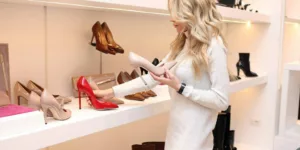While everyone wants a great product for their money, for many consumers it’s the experience of shopping that now dictates where they buy it from. Customers want more than a good price. They want the act of purchasing to be seamless and personalised, whether buying in-store or online. In this article, we’ll examine how these new consumer trends will change the way we shop during 2018.
The rise of omnichannel shopping
Until recently, most companies kept their online and in-store operations completely separate, almost as if they were different businesses. Consumers, of course, couldn’t see the logic in this. If you bought an item online and it was damaged, why couldn’t you return it to your nearest store and swap it for another? Or why was the item in your hand 10% more expensive than the one they were selling online?
Eventually, it seems businesses have taken the hint and, today, we are starting to see the rise of the omnichannel shopping experience, where retailers are removing the boundaries between the different shopping channels.
The success of this multichannel approach is because it is makes shopping far more user-friendly. For example, following in the footsteps of the big supermarkets and companies like Argos, companies are jumping on the ‘click and collect’ bandwagon. There are plenty of places where you can now buy online and pick up from the store. Even businesses that don’t have stores do this now, using collection services offered at places like the Post Office. The reverse is also true: if you don’t want something you bought online, the physical stores are more than happy to take it back.
In addition, physical stores are taking advantage of their online operations. If something isn’t in stock, they’ll order it online for you and have it delivered to your door the next day. The price difference between online and physical stores is also levelling out for those companies that operate both.
Generation Z
With millennials and Generation Z becoming such significant markets, their shopping habits have begun to have a much bigger influence on retailers. These technology reliant consumers use smartphones not just for buying but for product recommendations, price comparisons, communicating with stores, checking in and giving reviews. These are the shoppers who walk into a store, look at the physical product and then use their phone to find the best deal whilst still on the premises.
Such behaviour has been problematic for bricks and mortar stores, turning them into mere showrooms for internet shoppers. To counter this, retailers are now using a range of technologies which enhance the in-store shopping experience and give consumers what they cannot get online.
By using Bluetooth Low Energy (BLE) and RFID beacons and tags, which are capable of interacting with mobile phones, retailers have come up with some ingenious ways of attracting shoppers on site. By embedding RFID tags in advertising posters, for example, customers can use their phones to get product information, watch videos and even get discount vouchers or invites. All these forms of interaction can enhance the shopping experience and boost sales.
RFID and BLE tags, like those from Universal Smart Cards, have a wide range of uses. Besides linking to websites, videos and voucher codes, they can be used for booking services, ticket sales, and offering loyalty benefits. They can be placed almost anywhere too: on posters, shelves, individual products – both in and out of the store.
Hand in hand with omnichannel shopping, 2018 will see these technologies used much more to by bricks and mortar stores to provide the seamless shopping experience this young market requires.
Augmented Reality
One of the hottest trends in 2018 will be augmented reality online shopping. One of the problems with shopping online is that you don’t get to see the product properly before purchasing. This leads to a large number of returns and disappointed customers writing negative reviews. Augmented reality tries to overcome this by providing a better way to visualise the products than simply looking at a picture. As a result, retailers like Ikea have developed apps that enable consumers to see how their products will look in their own house. Simply choose a product, point your phone at the place you would put it in your home and suddenly it appears on your screen as if in your home. Users can even walk around the item to get a full 360° view.
Whilst this doesn’t enable the customer to have all the benefits of seeing the product in store: you can’t feel how comfortable a chair is or see how well something is made, it does offer a view that you cannot get even in-store and this is the advantage that is driving augmented reality forward.
Turning data into opportunity
Businesses are now able to collect vast quantities of valuable data from their consumers and, thanks to public cloud technology, this can be easily and cheaply analysed. Analysing Big Data enables retailers to get a detailed understanding of consumer demographics, location histories, buying habits and social media interactions. The software used for this analysis discovers patterns in customer behaviour and predicts future shopping trends, enabling retailers to make more accurate choices of which products to stock and showing them the best way to market them.
The companies which make use of this technology are the ones surviving in the challenging retail sector. To them, data analytics is a critical element in their success. It’s what makes it easier to forge those essential relationships with consumers. One of the key ways it does this is through providing customers with a personalised shopping experience. Amazon is a typical example of a store which does this well. When customers visit Amazon, they are instantly shown items which they are likely to be interested in. This is because the company has analysed all their data predicted the best products to display.
Physical stores are now making attempts to provide a similar personalised experience. Sales staff are being armed with devices which enable them to give customers highly detailed product information on site, including real-time stock availability, related items, customer reviews and accessories.
Wrapping up
Technology is reshaping how the retail sector operates and in 2018 we will see a range of new and existing technologies having increasing influence in the sector. Of these, omnichannel and personalised shopping will be the predominant trends with RFID and BLE, augmented reality and Big Data Analyses being the technologies that underpin their success.








